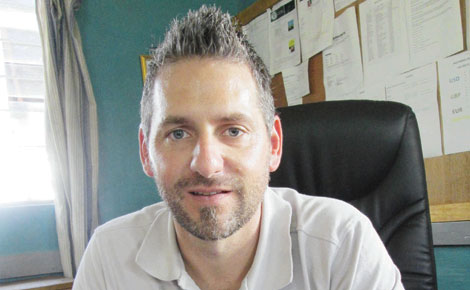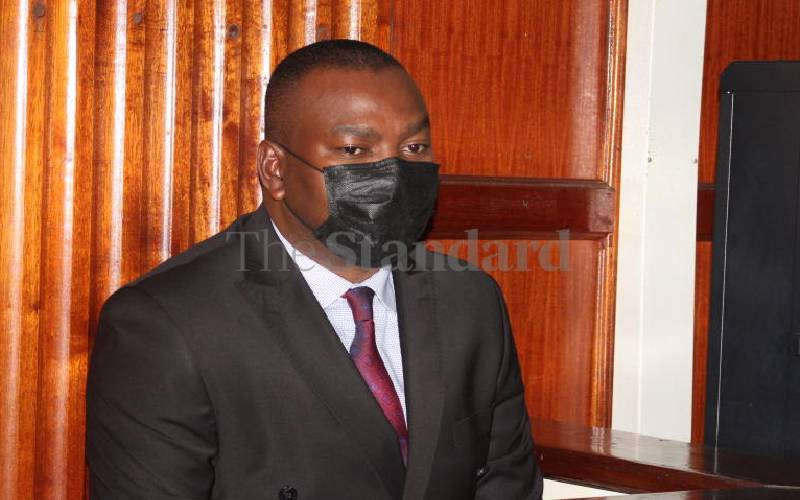 |
|
Jeff Longstaff, financial manager Kilimapesa Company. PHOTO: COURTESY |
By Amos Kareithi
Trans Mara, Kenya: In Kenya, the phrase gold-digger has always been a derogatory reference to men and women who enter a love relationship for the sake of money.
But unknown to many, there are real gold diggers in Kenya, furrowing the ground for the precious metal that fetches thousands a gramme. Well, this isn’t the story of the barefooted and poverty-stricken miners in parts of the country’s forgotten gold mines that were long abandoned. It is about a foreign investor who has literally struck a gold mine in Kenya, in Trans Mara to be precise.
We call the team the real gold diggers because of the capacity they have demonstrated and technology they have deployed. The Standard today takes you through a highly mechanised and windy operation leading to smelting — at the end of which the miners held in their hands a 13.5 kilogramme gold bullion, worth not less than US$450,000 (around Sh40 million).
The operation at Kilimapesa Mines, at Lolgorian in Trans Mara on Tuesday morning was the culmination of an exclusive story by The Standard three years ago that Kenya had struck gold in the region. But unlike then, and according to Kilimapesa Gold Pty limited, an affiliate of London-based Goldplat Plc, the prospects for higher yields are real.
The firm estimates it has deposits that can last them 20 years, and they have already identified a million gold pockets in the region.
However what is astounding is the length of time and intensity of work that leads to golden wedding rings, earrings and even neckchains and bracelets that the rich in world capitals spend millions of shillings to buy.
Then it turns out there is no rock called gold but the product is extracted from underground boulders which are crushed and milled into powder, before being turned into sludge using water, then a chemical is poured into the dirty mix to extract the tiny particles.
To get the picture of what goes on, consider the fact that the 13.5 kilogrammes of gold came from 340 tractor/trailer loads. This particular process took 105 days.
It is not unusual for the firm to extract three kilogrammes of pure gold from 750 tonnes of stone processed in a month.
This, experts say, now validates the country’s optimism and its prospects to produce 1,000 kilos of gold every month or 12 tonnes annually. A gramme goes for Sh2, 800 on the black market.
The smelting process depends on temperatures as high as 1,200 degrees centigrade to produce a single 13.5 kilo bar.
According to Mr Lojomon Biwott, a former commissioner of mines and non-executive director of Kilimapesa, Lolgorian has been producing gold for over a century, although this is the first time the mineral is being exploited by an international company on a large scale.
Just to show how precious the end product is, the bar was escorted down the gold mountain, coincidentally named Kilimapesa, by heavily armed guards on April 8.
The journey marked a new milestone in the mining of this precious commodity, which was discovered 121 years ago but has been largely ignored.
Stay informed. Subscribe to our newsletter
There are only two gold mining companies licensed in Kenya. The companies which have been granted leases are Kilimapesa, based in Transmara, and Karebe, which operates in Turkana.
After the smelting of the bar, Kilimapesa is now waiting for the grading and sale of the gold by their dealers in South Africa.
Despite the difficulties and astronomical costs of producing this gold bar, Kilimapesa believes its future and that of gold mining in the country is bright after demonstrating that Kenya is sitting on gold that can be exploited on a large scale to generate the much-needed foreign exchange.
Kilimapesa’s Financial Manager Jeff Longstaff explained that Lolgorian mines is now producing gold for parent company, Goldplat, which has other operations in South Africa, Ghana, and Burkina Faso.
High temperatures
He explained the smelting had to wait for over three months because a vital component of the elution plant had broken down and had to be procured from South Africa.
“Elution is the process of using chemicals to extract gold, which is absorbed in another substance by washing it out with a solvent,” he added.
The General Manager, Nicola Di Cio, explained that the rock containing specks of gold had to be excavated from the tunnels dug in the mountain, milled and then mixed with water.
On the day the historic gold bar was smelted by Kilimapesa Company, there was excitement as workers braved the high temperatures while monitoring the controls to ensure their gold cake had been appropriately baked and had the true colour of gold.
Inside this chamber, the molten gold was heated for four hours where borex, silica and nitric acids were used to purify the sludge before it was delicately poured out using long tongs made of cast iron to empty the product into the mould.
This process was done in a closed circuit, as some of the chemicals used in extraction of gold are highly dangerous, such as cyanide. The tanks containing the chemicals are in a restricted area only accessed by authorised personnel with protective clothing.
Longstaff said: “We started the production process on December 10, 2013 but we were held back when the elution plant went off line and we had to wait. Although this gold bar looks small, it is a product of processing 3,000 tonnes of raw material. This was brought to the site by 340 tractors.
The tonnes bearing the gold ore had been excavated under Kilimapesa mountain, through digging of tunnels where men work in shifts removing the material blasted away with explosives under the supervision of Mr David ole Mosingo, the senior blaster.
Kilimapesa, Biwott explained, was granted a special mining lease by the Mines and Geology Department on November 11, 2011 to mine in Lolgorian for 20 years after Sebimu, which had been mining in the area.
Besides the Government’s lease to mine, the company has to pay the local community Sh200,000 every month as ground rent for the 81.3 hectares it has been permitted to exploit.
Di Cio said the company was looking for a strategic investor who would inject some cash to enable Kilimapesa move its processing plant from its current location to the mountain.
“We have been spending a lot of resources and time to ferry the material down the mountain which is about 4.5 kilometres away. We also want to expand our processing capacity from the current 750 tonnes of ore, which produces about three kilos of gold to 6,000 tonnes, pushing our gold production to over 20 kilos of gold a month,” Di Nicio said.
Biwott believes that it is time for the Government to regulate the mining sector, as the laws regulating the industry are archaic. “The Government should also invest in exploration and sell this data to prospecting companies. It is very expensive to conduct explorations. A company wishing to start commercial mining must have more than Sh5 million,” Biwott added.
 The Standard Group Plc is a
multi-media organization with investments in media platforms spanning newspaper
print operations, television, radio broadcasting, digital and online services. The
Standard Group is recognized as a leading multi-media house in Kenya with a key
influence in matters of national and international interest.
The Standard Group Plc is a
multi-media organization with investments in media platforms spanning newspaper
print operations, television, radio broadcasting, digital and online services. The
Standard Group is recognized as a leading multi-media house in Kenya with a key
influence in matters of national and international interest.
 The Standard Group Plc is a
multi-media organization with investments in media platforms spanning newspaper
print operations, television, radio broadcasting, digital and online services. The
Standard Group is recognized as a leading multi-media house in Kenya with a key
influence in matters of national and international interest.
The Standard Group Plc is a
multi-media organization with investments in media platforms spanning newspaper
print operations, television, radio broadcasting, digital and online services. The
Standard Group is recognized as a leading multi-media house in Kenya with a key
influence in matters of national and international interest.








